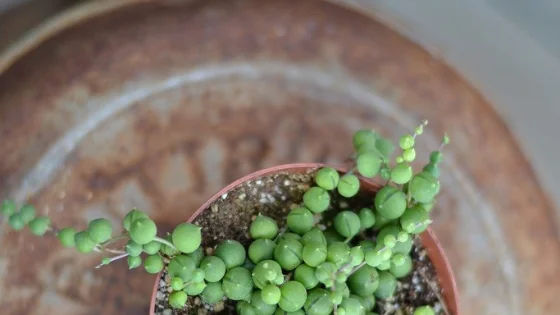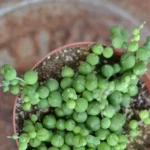Table of Contents
Overview
The string of pearls is one of the best succulents to grow indoors. The plan gives you the benefit of a carefree growing habit in addition to a focal point in your household.
The plant resembles a beaded necklace as it sprawls over the edges of the containers’ hanging baskets. The plant’s foliage is fleshly green and usually appears like peas.
If you’d consider having this plant growing in your indoors, it’s essential to understand its care tips and what you could do to make it thrive even more effectively.
I have prepared this article to provide detailed information about the String of Pearls watering because this is one of the best care routines that will help maintain the plant in good growing conditions.
Growth Conditions
Sufficient String of Pearls Watering is critical to the good thriving of the plant. The plant will grow perfectly under the average indoor temperatures in its entire growth life. However, the dormancy conditions require a cooler temperature of between 10 and 13 degrees Celsius.
To support watering, you should give the plant well-drained soil that supports the growth of succulent plants like cacti. When you put soil in the baskets, you should hang them to allow the foliage to hang downwards as they grow along.
Read more: Common Problems with String of Pearls Plant
The string of Pearls Watering Tips
The String of Pearls Watering is the biggest task you will undertake when caring for the plant. But it is essential to know the right time that watering should be carried out to the String of Pearls.
You can determine whether your plant needs water by looking at its beads. When your String of Pearls needs watering, its beads will appear as if they are wrinkling or shriveling, looking kind of like raisins.
When you make such an observation, you need to know that your plant requires immediate watering because it is very dry. But there’s no need for waiting to see the beads shriveling so that you can start the watering routine.
The most crucial point is to make sure you find the right balance between the best watering moment and the time you hold back from watering the plant.
The plant has no need for frequent watering. However, you should water thoroughly when you commit to undertaking this exercise.
The String of Pearls Watering is not encouraged until the soil dries up. My experience with these plants has made me conclude the requirement to water smaller plants more often than the bigger ones because bigger plants have a higher water storage capacity that can sustain them for long.
The string of Pearls Watering in Summer
The plant and soil lose water at the fastest rate during summer. As such, it is essential to check your plant regularly during summer than in other seasons. Other than watering, protection of the sunlight is very critical.
More so, water at least once a week and ensure that you do not just sprinkle water onto the plant but give it enough water to ensure it gets full hydration.
The watering routine could change as the weather gets cooler in the spring and fall. In such a season, the recommended watering frequency should be about one time in a period of two weeks. However, you can reduce this frequency based on the condition of your plants.
Read more: How to Repot String of Pearls
The string of Pearls Watering in Winter
Winters are the periods when we experience a lot of rainfall and cool climates. If the plants are not exposed to direct rainfall, watering once a month is recommended.
However, the watering needs may not be necessary when the plan is going in your backyard because the rainwater will be sufficient for the plant during the winter season.
The string of Pearls Watering During Propagation
Propagation is one of the most delicate stages in the String of Pearls’ routine management and care. The plant is usually vulnerable to diseases and drying. During this stage, you should practice regular watering any time you feel your soil dry.
You can water in a frequency of once in a week or a closer duration regardless of the year’s season. Allowing the stem cuttings to go for long without water can cause drying and failure to survive, hence watering the plants regularly.
Read more: Is String of Pearls Toxic to Cats
Frequently Asked Questions
How do I know if my string of pearls needs water?
You can observe the plant to see if it looks shriveled. If the case you water your plant and still notice that it is shriveling, it’s essential to increase your watering frequency.
For smaller plants, you can feel the soil texture at the bottom of the pot for dryness and water whenever it feels dry because smaller plants might be more vulnerable.
Should you bottom water string of pearls?
Bottom watering of the String of Pearls is recommended for those whose pots support bottom watering practice.
But when the pot does not support this watering system, then the top watering is also okay, given that the circulation of the air is good at the surface of the soil. Bottom watering the string of pearls is also good in preventing overwatering.
Read more: Why Is My String Of Pearls Dying
Why is my string of pearls drying up?
The main reason that the plant may start drying up is because of the watering issues. The plants store water in their round leaves, which, when it runs low, may begin to appear like it is drying up.
The cases are more common among the young plants, which usually require a lot of water than the mature plants.
Can you keep the string of pearls in the water?
No. You cannot keep the string of pearls in water because excessive water can affect the plant by causing shriveling. You are required to provide only the recommended amounts to maintain a balance.
When the string of pears watering results in more than the plant’s required water, the leaves may burst and make the plant appear mushy. Thus, you cannot keep the plant in water.
Read more: String Of Pearls Propagation
What does an overwatered string of pearls look like?
Overwatering a string of pearls plant makes its leaves burst. It will also make the plant appear mushy and shriveling.
An excessive among of water is not good for the plant. This is why you must know the right water volumes you will pour into the pot for the right water balance in the plant
Image by Veronica Bosley from Pixabay



